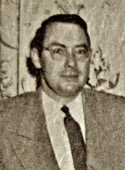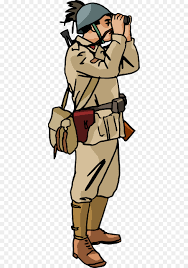Uncle Bill and World War II - Battle of the Hedgerows and the Battle of St. Lo
Editor's Note: When you see these three dots surrounded by a gray rectangle — 1 — you can click on it to get further information about the topic. Click a second time, and the message goes away.

NOTE: My mother's brother, my Uncle Bill, participated in many of the major battles of the European theatre during World War II. This page and others reveal his experiences. For a full listing, see the bottom of this page. The photo at left is one of the rare photos I have of my uncle. It was taken after the war.
The Hedgerows

As troops moved inland from the beaches, they encountered resistance nearly everywhere, and the hedgerows became a particular problem. Planted to take the place of fences, the hedges were on average five meters tall, well maintained and ubiquitous in the area. Originally built by the Romans, the hedgerows at first were simple mounds of dirt raised in irregular patterns that served as fences between plots of land. Irrigation ditches with raised sides provided water to all the fields and animals. 2
Bottom line: Hedges were very difficult to pass through and they slowed everyone down. 3 They were clearly much more of a problem than the military originally thought they would be.
First, the Bombs -- or so they thought
“We waited several weeks in that hedgerow country trying to find a break in the German lines. One day we learned what was about to happen. An infantry company was in the field to the right of us. They [were] being briefed on what was to happen. A giant armada of American bombers was to bomb an area of the German lines about ten miles in length, three miles in width, just saturate that area with bombs, bombs, bombs. Then this infantry company, with others would go through and fan out to the right to protect the right flank. We found out we would go through this break in the German lines as soon as infantry and tanks were through.

“The plan misfired. The American bombers did not do as Eisenhower had repeatedly … ordered. He ordered them to fly parallel to the lines…along the ten-mile length. But to minimize anti-aircraft fire the bombers flew from our lines to German lines cutting down the time they’d face anti-aircraft fire. Many bombs fell short and killed many American soldiers. I’ve read in books on World War II how Ike was furious. He wanted to sack half the airforce generals in England.
“So the bombers came again. This time they did it right. We crossed this area that was three miles deep. There wasn’t a tree left standing, no houses or barns left standing. The ground was churned by thousands and thousands of bombs. And we broke through the German defences.
And now those gas clothes are needed!
“About the time of the breakout out of the hedgerow country most soldiers had long ago thrown away [their] anti-gas clothing. 4 I’m sure no one was wearing it. Mine was in my duffel bag. Field artillery soldiers had the advantage of trucks to carry their duffel bags. Infantry soldiers didn’t. Then one late afternoon when tens of thousands of us were crowded together in field waiting for a breakout every one of us wished we’d had our anti-gas clothing.
“I was playing poker in a medical tent when the sound of “gas……..gas……..gas” came everywhere. All of us immediately put on our gas masks. Damn. The war was taking a bad turn…..gas. Then came the call, “All clear.” Then again, “Gas…..gas…..gas.” On went the gas masks. And everybody who had anti-gas clothing available started stripping down and putting it on. A thought I have many, many, many times is these fields of men stripping naked and pulling on that dark brown smelly underwear. The cries of “gas…..gas…..gas….” kept coming. I think all of us spent a sleepless night wondering what the morning would bring.
“A few days later the word was passed down in command that this scare was caused by a German shell that hit a mount of newly cut hay and newly cut burning hay leaks phosgene gas. Everybody got a lecture on not panicking but I was a long time in throwing away my brown underwear."
My uncle's final comment about the results of the Battle of the Hedgerows and St Lo:
“This was done by the Seventh Corp, not by Patton’s Army."
Here are the other battles that Bill experienced:
- Normandy June 6, 1944
- The Battle of Cherbourg June 18, 1944
- Battle of the Falaise Pocket August 11-21, 1944
- Battle of the Hurtgen Forest September 19 - December 6, 1944
- The Fall of Aachen October 2-21, 1944
- Battle of the Bulge December 15, 1944 - January 25, 1945
Or return to Main Page to check out other battles, other stories.